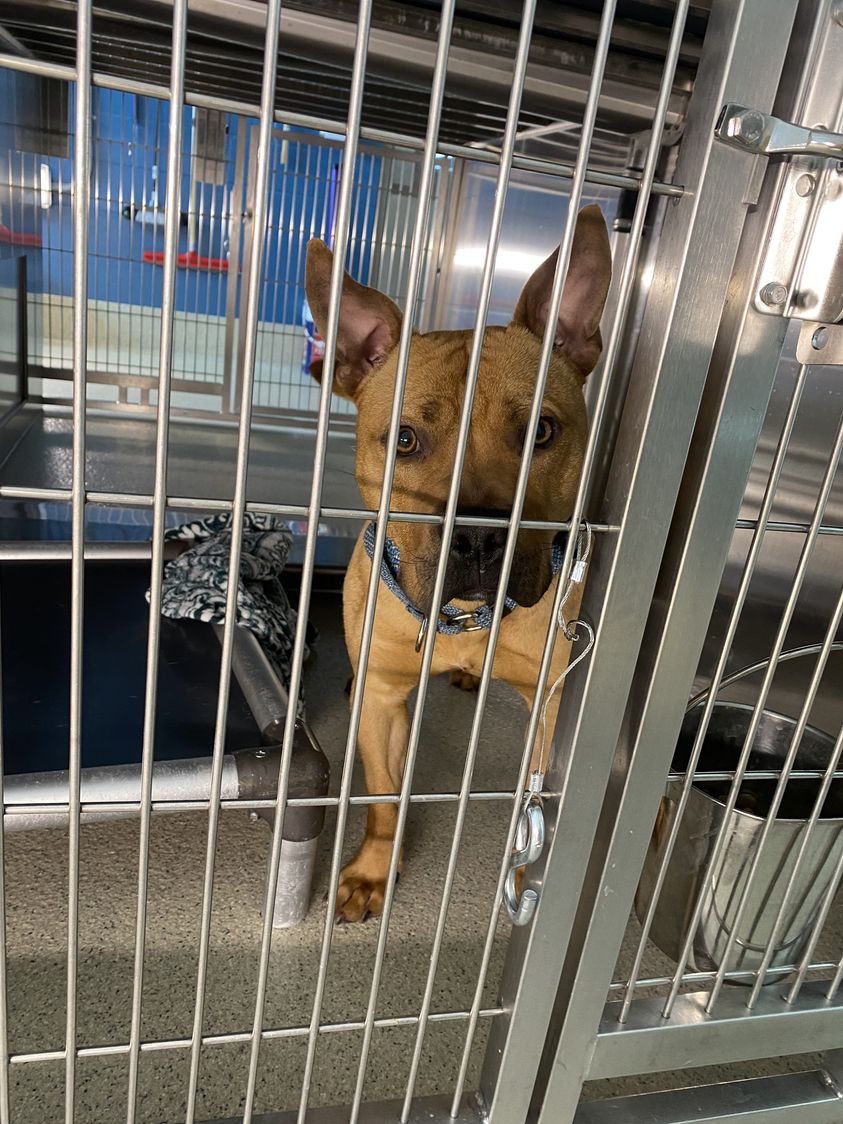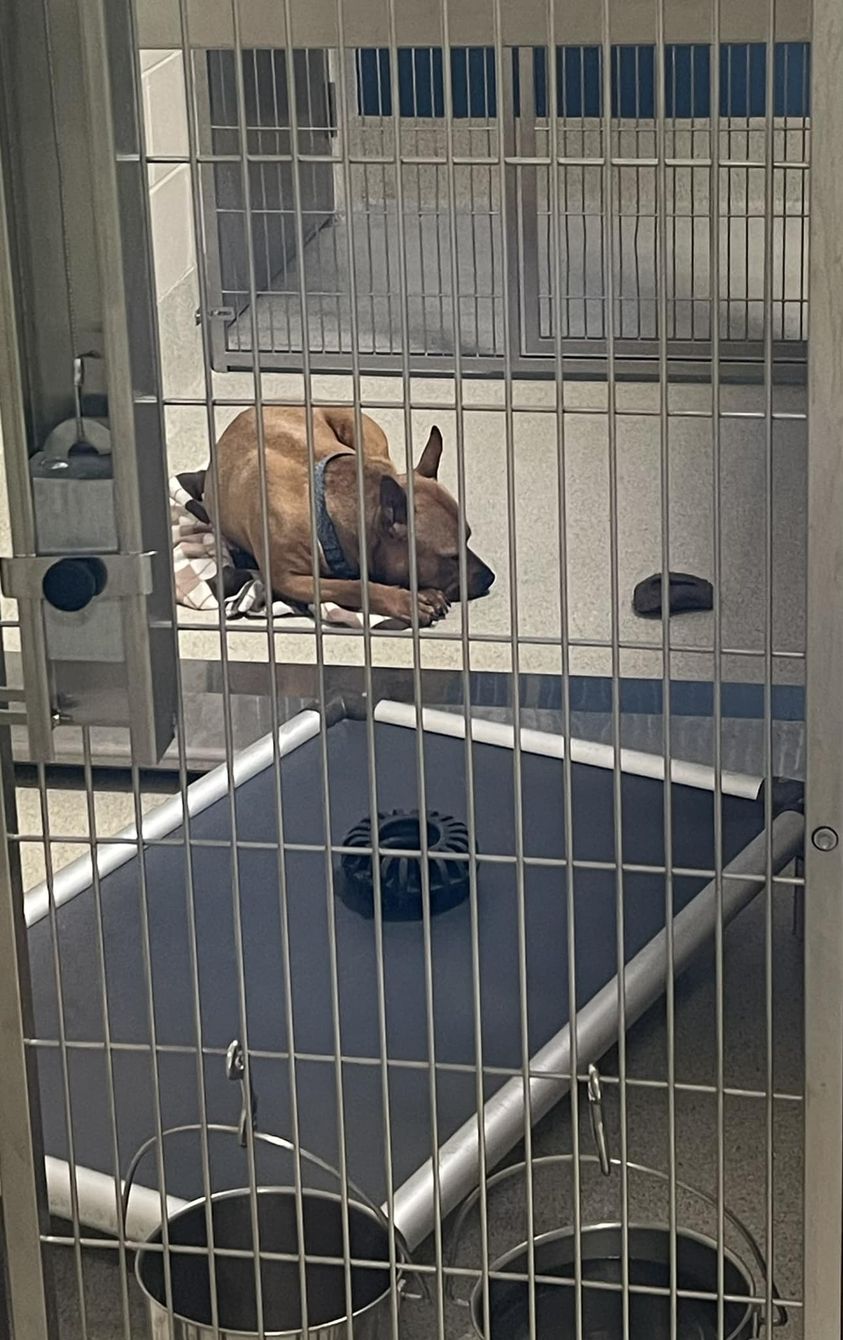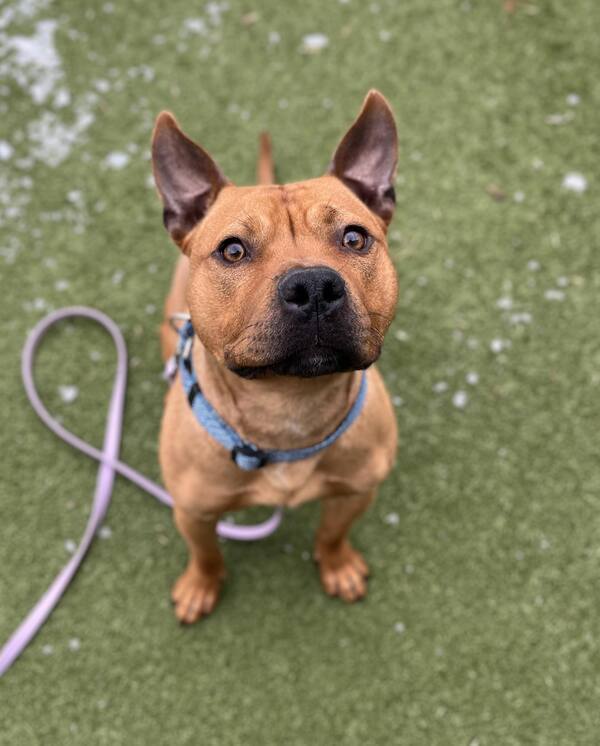Every year, more and more dogs end up in shelters, and it seems that the trend is not slowing down. Because the capacities of these facilities are not limitless, the conditions in them are worsening as time goes on.
Aside from that, despite providing them with food and a place to live, numerous studies show the negative effects of the shelter on a dog’s well-being. Just the absence of regular human hugs can be devastating for them, not to mention other things.
The state in which one dog found himself in a shelter in Pontiac, Michigan, pictures these bad consequences the best. He was so sad and tired of loneliness that he didn’t have the energy to even get up on his paws.
Fortunately, the photo of him lying in his kennel, tired of being alone, touched many hearts and helped him meet his happiest moment.
Favourite Shelter Pup

On February 24, 2024, the Oakland County Animal Control & Pet Adoption Center, located in Pontiac, Michigan, wrote a Facebook post in which they introduced followers to their new shelter dog.
“Meet Tiny Tim!!!” they wrote. “This tiny ham is only 1 years old. He is the cutest thing you will ever see! At just 39 pounds, he is the best little low rider bestie you will ever have!!
A manager at the shelter, Bob Gatt, told Newsweek that he had “no identification, no microchip and no license” when he came. They tried to find his previous owner with the help of social media and online platforms, but it was all in vain.
Since no one claimed him, Tiny Tim became a member of the shelter family. In a very short time, the staff fell in love with him, and he became the favorite pup there.
“He’s young, friendly, and curious. His goofy nature and smart demeanor make him a joy to be around,” Gatt said.
The shelter employees also stated that he “gets along well with other dogs, always eager to make new friends” and “he’s also a gentleman when it comes to taking treats, always gentle and polite.”
Considering all these positive traits as well as his loving personality, they were convinced that the moment of his adoption was a matter of days.
Heartbreaking Photo

To the disappointment of all shelter employees, the days and weeks passed, but no one called them and expressed a desire to adopt Tiny Tim.
A month after he came to their shelter, they posted a video of sad Tiny Tim behind the bars of his kennel in the hope that someone would notice him and give him a forever home.
“I am a fun loving fella who loves playtime, walks and cuddles. I hope to meet a loving family who will give me time to adjust to my new surroundings. I hope to meet you soon,” the video caption read.
Unfortunately, it was all in vain, and poor Tim had to continue his life behind bars. He became increasingly discouraged and began to lose hope that he would ever meet his happy ending.
On March 16, the shelter wrote one of their saddest Facebook posts with the heartbreaking photo of Tiny Tim lying on the floor in his lonely corner.
“Tiny Tim is still here. He’s tired and lonely, and tired of being lonely…😢,” they wrote.
Soon after, this post and picture caused numerous reactions and broke many hearts.
Happy Ending

Reactions to Tim’s picture from the shelter came one after the other. Most of the comments reflected the broken hearts of the people who saw the photo.
“Omg, poor boy needs a curl up…” one user wrote.
“So sad i wish i could save all animals xx,” another added.
And, the third cried out: “Aw praying he finds his forever home.”
To the delight of this woman who wished him a forever home, as well as all the good people who were familiar with his life story, a few days after this post, Tiny Tim finally met his happy ending.
In the last Facebook post about his life in the kennel, from March 26, the shelter soon wrote an update with just one happy word: “***Adopted!!!🥳🥳🥳***.”
After the door of his kennel opened, the dog, once “tired of loneliness”, energetically jumped to his paws, put a smile on his face, and headed toward his new beginning.
If you’re a dog owner, you know the unconditional love and joy your furry friend brings into your life. However, when faced with the tough reality of mast cell tumors in dogs, the decision-making process can be overwhelming. As an experienced dog trainer, navigating the journey of when to stop fighting these tumors can be emotionally challenging yet crucial for your pet’s well-being.
Understanding the signs, treatment options, and knowing when to consider quality of life over quantity is a delicate balance. Your dog’s comfort and happiness are paramount, and knowing when to let go of the fight against mast cell tumors is a decision that requires careful consideration and love for your loyal companion.
Understanding Mast Cell Tumors in Dogs
Mast cell tumors in dogs are common, accounting for about 20% of all skin tumors. These tumors can vary in size, location, and aggressiveness, making each case unique. It’s crucial to understand the nature of these tumors to make informed decisions regarding your dog’s well-being.
Identifying Mast Cell Tumors
- Signs: Look out for raised skin lumps, hair loss, itchiness, and redness.
- Behavior: Monitor changes in your dog’s behavior, such as lethargy or loss of appetite.
- Veterinary Examination: Your vet can perform tests like fine-needle aspiration to diagnose the tumor.
Grading and Staging
- Grading: Tumors are graded based on their aggressiveness.
- Staging: Determines the extent of cancer spread in the body.
Treatment Options
- Surgery: Common for removing localized tumors.
- Chemotherapy: Helps in cases of aggressive or metastatic tumors.
- Radiation Therapy: Used to shrink tumors before surgery or for palliative care.
Quality of Life Considerations
- Pain Management: Ensure your dog is comfortable throughout treatment.
- Side Effects: Understand potential side effects of treatments.
- Life Expectancy: Discuss with your vet the prognosis and potential outcomes.
- Consultation: Have open discussions with your vet regarding treatment options.
- Comfort: Prioritize your dog’s comfort and well-being.
- Quality of Life: Evaluate your dog’s happiness and overall quality of life.
Understanding mast cell tumors empowers you to make decisions that prioritize your dog’s health and happiness. Work closely with your vet to determine the best course of action for your furry companion.
Factors to Consider When Deciding to Treat Mast Cell Tumors
When deciding whether to treat mast cell tumors in your dog, several crucial factors should guide your decision:
1. Tumor Grade and Stage
Assess the grade and stage of the tumor to understand its aggressiveness and spread. This information is vital in determining the appropriate treatment approach.
2. Overall Health Status
Consider your dog’s overall health and any pre-existing conditions. Treatment can be more challenging for dogs in poor health, affecting their ability to tolerate therapies.
3. Potential Side Effects
Be aware of the potential side effects of different treatment options such as surgery, chemotherapy, or radiation therapy. Understanding these risks will help you make an informed decision based on your dog’s well-being.
4. Quality of Life
Evaluate your dog’s quality of life throughout the treatment process. Balancing the benefits of treatment with any discomfort or pain your dog may experience is essential.
5. Financial Considerations
Factor in the cost of treatment, including surgery, medications, and follow-up care. Ensure you can afford the necessary care without compromising other aspects of your dog’s well-being.
6. Consultation with Veterinarian
Engage in open discussions with your veterinarian to understand the treatment options available and their potential outcomes. Your vet’s expertise and guidance are invaluable in making an informed decision.
7. Your Dog’s Comfort
Prioritize your dog’s comfort and well-being throughout the treatment process. Monitor their happiness and behavior to ensure they are not overly stressed or in discomfort.
8. Family Support
Consider the support system available to you and your dog during treatment. Family members and friends can provide emotional support, helping you and your dog navigate the challenges ahead.
9. Long-Term Prognosis
Discuss the long-term prognosis with your veterinarian to understand the potential outcomes of treatment. Knowing what to expect can help you prepare emotionally and make decisions in the best interest of your dog.
Signs It May Be Time to Stop Fighting Mast Cell Tumors
Monitoring the Tumor’s Progress Regularly
Keep an eye on the tumor’s growth and any changes in its size or appearance.
Declining Quality of Life
If your dog shows signs of persistent pain, discomfort, or loss of interest in activities, it may be time to reconsider treatment.
Unmanageable Side Effects
Watch for severe side effects from treatments that significantly impact your dog’s well-being.
Deteriorating Health Condition
If your dog’s overall health deteriorates, with complications affecting their ability to respond to treatment or enjoy daily life, it could be a sign to stop fighting the tumors.
Veterinarian’s Recommendation
Consult your veterinarian for their professional opinion on the best course of action based on your dog’s specific condition.
Emotional Well-Being of Your Dog
Consider your dog’s emotional well-being and happiness throughout the treatment process.
Financial Constraints
If the financial burden of treatment becomes overwhelming, it may be necessary to prioritize your dog’s comfort and well-being.
Consulting with a Veterinary Oncologist
If you notice your dog’s mast cell tumors are no longer responding to treatment, it might be time to consult with a veterinary oncologist. These specialized veterinarians are experts in cancer treatment for animals and can provide valuable insights into your dog’s condition.
- Professional Opinion:
- Understanding the Situation: A veterinary oncologist can assess your dog’s overall health and the progression of the mast cell tumors to offer a professional opinion on the next steps.
- Treatment Evaluation: They can review the effectiveness of the current treatment plan and suggest alternative options if necessary.
- Quality of Life Assessment:
- Balancing Care and Comfort: A veterinary oncologist can help you evaluate your dog’s quality of life, taking into account factors like pain levels, side effects of treatment, and overall well-being.
- End-of-Life Care:
- Compassionate Guidance: In situations where further treatment may not be beneficial, a veterinary oncologist can guide you on providing the best end-of-life care for your beloved pet.
- Decision-Making Support:
- Informed Choices: Consulting with a veterinary oncologist ensures that you have all the information needed to make informed decisions about your dog’s care, including when to consider stopping treatment.
- Emotional Support:
- Understanding Your Feelings: Dealing with a pet’s illness can be emotionally challenging. A veterinary oncologist can provide support, empathy, and guidance during this difficult time.
When you reach a point where the treatment no longer benefits your dog and the focus shifts to maintaining their comfort and quality of life, consulting with a veterinary oncologist can provide the clarity and support you need to make the best decisions for your furry companion.
Making the Decision: When to Transition to Palliative Care
When deciding to transition to palliative care for your dog with mast cell tumors, it’s crucial to consider various factors to ensure their comfort and well-being.
- Quality of Life Assessment: Assess your dog’s quality of life regularly. If treatments are no longer effective, and your dog’s happiness and comfort are declining, it may be time to transition to palliative care.
- Veterinarian’s Guidance: Consult with your veterinarian, especially if the tumors are not responding to treatment. They can evaluate the situation, provide insights on the effectiveness of treatment, and discuss options for palliative care.
- Emotional Well-being: Consider the emotional well-being of your furry companion. Palliative care focuses on keeping your dog comfortable and happy, allowing you to cherish the time you have left with them.
- Treatment Side Effects: If the side effects of treatment are becoming unmanageable for your dog, transitioning to palliative care can help reduce their discomfort.
- Financial Considerations: Evaluate the financial implications of continued treatment versus transitioning to palliative care. Ensure that you can provide the best care for your dog without causing financial strain.
Remember, the decision to transition to palliative care is a compassionate choice aimed at enhancing your dog’s quality of life during their final days. Consult with your veterinarian to ensure you make the best decision for your beloved pet.
Conclusion
Knowing when to stop fighting mast cell tumors in your dog is a tough decision. It’s essential to prioritize your dog’s well-being and quality of life above all else. Understanding the signs and treatment options is crucial. Remember, consulting a veterinary oncologist can provide valuable insights. Transitioning to palliative care is about ensuring your furry friend’s comfort and happiness in their final days. Trust your instincts and seek guidance from professionals to make the best choice for your beloved companion.
Frequently Asked Questions
What are mast cell tumors in dogs?
Mast cell tumors are abnormal growths on a dog’s skin that can vary in severity from benign to malignant. They are often found in the skin or underlying tissues and can cause various symptoms like itching, swelling, or ulceration.
How are mast cell tumors in dogs diagnosed?
Diagnosis of mast cell tumors in dogs involves a thorough physical examination, fine-needle aspirate or biopsy for confirmation, and potentially additional tests like bloodwork, X-rays, or ultrasound to assess the tumor’s extent.
What are the treatment options for mast cell tumors in dogs?
Treatment options for mast cell tumors in dogs may include surgery to remove the tumor, chemotherapy, radiation therapy, and targeted therapies. The choice of treatment depends on the tumor’s grade, size, and location.
How can dog owners improve their pet’s quality of life during mast cell tumor treatment?
To enhance a dog’s quality of life during mast cell tumor treatment, dog owners can focus on proper pain management, monitoring for side effects, providing a comfortable environment, ensuring a nutritious diet, and offering emotional support.
When should a dog transition to palliative care for mast cell tumors?
Transitioning to palliative care for mast cell tumors in dogs is recommended when the conventional treatment options are no longer effective, and the focus shifts to maintaining the dog’s quality of life, managing symptoms, and ensuring comfort in their final days.
[no_toc]

Hey there, I’m Janet Brooks, a dog-loving student from California. I’m all about helping pups in need, especially those without homes. Me and my awesome friends work together to give shelter and love to stray dogs. Oh, and I also write blogs about dogs to share helpful info.